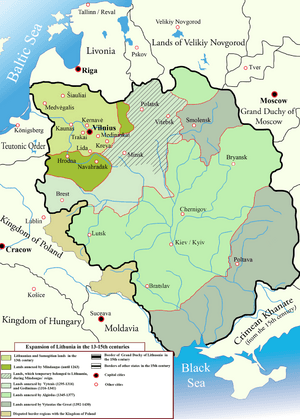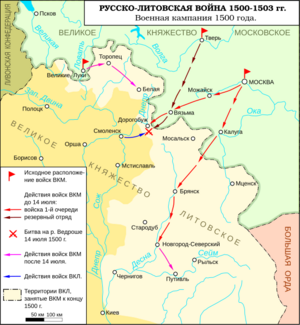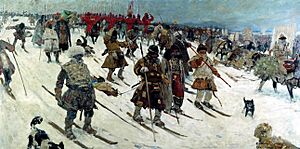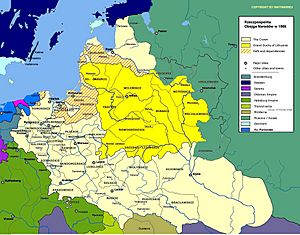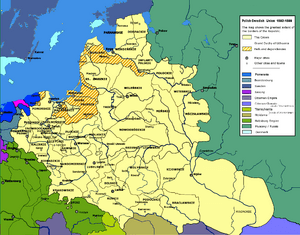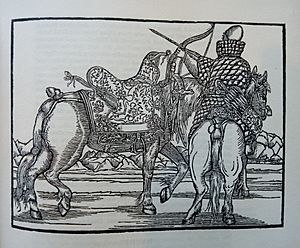Muscovite–Lithuanian Wars facts for kids
The Muscovite–Lithuanian Wars were a series of big conflicts between the Grand Duchy of Lithuania (which was allied with the Kingdom of Poland) and the Grand Duchy of Moscow. Moscow later became the Tsardom of Russia.
After losing several battles to leaders like Ivan III and Vasily III, Lithuania needed more and more help from Poland. This help eventually led to the creation of the Polish–Lithuanian Commonwealth.
Before these wars started in the 1400s, Lithuania controlled a huge area of Eastern Europe, from Kyiv to Mozhaysk. This was after the Kievan Rus' state fell apart because of Mongol invasions. But during these wars, especially in the 1500s, Moscow grew bigger and took control of many smaller regions to its west.
Contents
How the Wars Started
Lithuania Grows Stronger (1300s)
The Grand Duchy of Moscow and Lithuania had been fighting for a long time. It started during the rule of Gediminas, a Lithuanian leader. He won a battle against a group of princes near the Battle on the Irpin River and took over Kyiv, which used to be the capital of Kievan Rus'.
By the mid-1300s, Lithuania had also taken over areas like Chernihiv and Severia. Algirdas, who ruled after Gediminas, teamed up with the Principality of Tver. He attacked Moscow three times, trying to take advantage of the young Moscow leader, Dmitry Ivanovich. But Dmitry managed to defend Moscow each time.
Algirdas's troops first entered Moscow's land in 1363. In 1368, he led a big attack, destroying areas around Moscow and capturing many people. But he couldn't capture the Moscow Kremlin. In 1370, he attacked again and surrounded Moscow, but he left when he heard that another prince was coming to help. In 1372, Algirdas attacked Moscow again, but Dmitry Ivanovich defeated his scouts, and they agreed to a truce.
Some people in Moscow wanted to take back all the lands that used to belong to Kievan Rus', which were now mostly controlled by Lithuania. Moscow also wanted better access to the Baltic Sea for trade. So, the fighting between Lithuania and Moscow was just beginning.
Moscow Becomes Stronger (1400s)
The conflicts started again when Dmitry's son, Vasily I, became ruler. Vasily was married to Sophia, the daughter of the powerful Lithuanian Grand Duke Vytautas the Great.
In 1394, Vytautas attacked the Principality of Ryazan, burning many towns. In 1402, he argued with his son-in-law Vasily over who controlled the Principality of Smolensk. Vytautas captured Smolensk's capital. The former ruler of Smolensk, Yury of Smolensk, asked Vasily for help. Vasily was worried about Lithuania growing too strong, so he sent an army to help the people of Pskov against Vytautas. The Russian and Lithuanian armies met near the Ugra River, but neither side attacked. They made peace, and Vytautas kept Smolensk.
First Border War (1487–1494)
Ivan III saw himself as the heir to the old Byzantine Empire and a protector of the Eastern Orthodox Church. He called himself "sovereign of all Rus'" and claimed he had a right to all the lands that used to be part of Kievan Rus'. This led to Moscow's territory and power growing steadily.
The rule of the Golden Horde (known as the "Mongol Yoke") ended in 1480. Moscow then expanded its influence, taking over the Principality of Ryazan in 1456, the Novgorod Republic in 1477, and the Principality of Tver in 1483. Ivan III's plans to expand further clashed with Lithuania's interests.
Around 1486–87, Moscow and its ally, Meñli I Giray, the Khan of Crimea, attacked areas along the unclear border between Lithuania and Moscow near the Oka River. Tensions kept rising. In August 1492, without declaring war, Ivan III began major military actions. He captured and burned several towns and attacked the lands of the Dukes of Vyazma. Many Orthodox nobles started joining Moscow because it promised better protection and an end to religious unfairness from the Catholic Lithuanians.
Ivan III officially declared war in 1493, but the fighting ended quickly. The Grand Duke of Lithuania, Alexander Jagiellon, sent people to Moscow to make a peace treaty. An "eternal" peace treaty was signed on February 5, 1494. This agreement was the first time Lithuania lost land to Moscow. It lost the Principality of Vyazma and a large area near the Oka River, estimated to be about 87,000 square kilometers. A day before the treaty was confirmed, Alexander Jagiellon was engaged to Helena, Ivan III's daughter.
Second War (1500–1503)
Fighting started again in May 1500. Ivan III took advantage of Poland and Hungary planning a campaign against the Ottoman Empire. He knew they wouldn't be able to help Lithuania. The reason given for the war was that Orthodox Christians were supposedly being treated unfairly in Lithuania. Ivan III had forbidden his daughter Helena to change to Catholicism. This gave him many chances to get involved in Lithuanian affairs as the "defender of all Orthodox Christians."
The Muscovites quickly took over Lithuanian forts in places like Bryansk, Vyazma, and Putyvl. Local nobles often joined the Muscovite side. Another attack came from the southeast into areas like Kiev Voivodeship. On July 14, 1500, the Lithuanians suffered a big defeat in the Battle of Vedrosha, and their military leader, Lithuanian Grand Hetman Konstanty Ostrogski, was captured. This defeat was one reason for a proposed union between Poland and Lithuania. In November 1501, the Lithuanians lost again in the Battle of Mstislavl. The Crimean Tatars, who were allies of Lithuania, destroyed the Golden Horde by conquering its capital in 1502.
In June 1501, John I Albert, the King of Poland, died. His brother, Alexander Jagiellon, the Grand Duke of Lithuania, was the strongest candidate for the Polish throne. Alexander became busy with becoming king. To deal with the religious accusations, Alexander tried to unite Catholics and Orthodox Christians, where Orthodox Christians would keep their traditions but accept the Pope as their spiritual leader. The Metropolitan of Kiev agreed, but Helena protested.
Meanwhile, the war continued, but Moscow wasn't doing as well. The Livonian Order, led by Wolter von Plettenberg, joined the war as Lithuania's ally. Livonian troops won battles in August 1501 and September 1502. In 1502, Ivan III tried to capture Smolensk, but the city held out because the Muscovites used a poor strategy and didn't have enough cannons.
Peace talks began in mid-1502. Alexander asked the King of Hungary to help mediate, and a six-year truce was agreed upon on March 25, 1503. The Grand Duchy of Lithuania lost about 210,000 square kilometers, which was about a third of its territory. This included Chernihiv, Novhorod-Siverskyi, Starodub, and lands around the upper Oka River. The Lithuanians also recognized Ivan's title, "sovereign of all Rus'."
Third War (1507–1508)
In 1506, Alexander died. Vasili III, who became ruler of Moscow after his father Ivan III in 1505, tried to become King of Poland. But Polish nobles chose Sigismund I the Old, who became both King of Poland and Grand Duke of Lithuania. In 1507, Sigismund I sent messengers to Moscow to ask for the return of the lands lost in the 1503 truce. At the same time, Khan Meñli I Giray ended his alliance with Moscow.
This war was connected to a rebellion led by Michael Glinski, a Lithuanian official. Glinski was a favorite of Alexander Jagiellon, but Sigismund I didn't favor him as much. Another official accused Glinski of treason, saying he poisoned Grand Duke Alexander and wanted to be king. Glinski then started a rebellion, killed his opponent, and said he was defending the Orthodox faith (even though he was Catholic). He tried to capture several towns but only managed to take Mazyr.
Near Orsha, Glinski joined with Muscovite forces but was defeated by the Lithuanian military leader Konstanty Ostrogski. These defeats showed that the rebellion, despite claiming to protect Orthodox rights, didn't have much support from the common people. The war ended with an "eternal peace treaty" on October 8, 1508. This treaty kept the borders as they were after the 1503 truce.
Fourth War (1512–1522)
Even with the peace treaty, relations between the two countries were tense. Sigismund I wanted Michael Glinski to be sent back for trial, while Vasili III demanded better treatment for his widowed sister Helena. Vasili also found out that Sigismund was paying Khan Meñli I Giray to attack Moscow.
In December 1512, Moscow invaded Lithuania, trying to capture Smolensk, an important trading city. Their first two sieges in 1513 failed, but the city fell in July 1514.
Russia then suffered several defeats in battles. In 1512, Konstanty Ostrogski defeated a 6,000-strong Russian force. On September 8, 1514, the Russians lost a major battle at Battle of Orsha. Despite this victory, the Lithuanian army couldn't move fast enough to recapture Smolensk. In 1518, Russian forces were defeated during the siege of Polotsk. According to a story, Lithuanian forces were inspired by seeing their patron saint, Saint Casimir. The Russians invaded Lithuania again in 1519, raiding several towns.
By 1521, Sigismund had defeated the Grand Master of the Teutonic Order and allied with the Kazan and Crimean Tatars against Moscow. The Khan of Crimea attacked Moscow, forcing the Grand Prince to agree to pay tribute. Lithuanian troops also took part in this attack.
In 1522, a treaty was signed for a five-year truce. It said there would be no prisoner exchange, and Russia would keep control of Smolensk. The truce was later extended until 1534.
Fifth or Starodub War (1534–1537)
When Vasily died in 1533, his son and heir, Ivan IV, was only three years old. His mother, Elena Glinskaya, ruled for him and had power struggles with other relatives. The Polish–Lithuanian ruler decided to take advantage of this and demanded the return of territories that Vasily III had conquered.
In the summer of 1534, the Lithuanian military leader Jerzy Radziwiłł and the Tatars attacked areas around Chernigov and Starodub. In October 1534, a Muscovite army invaded Lithuania, reaching as far as Vilnius. They built a fort on Lake Sebezh the next year. The Lithuanian army then launched a strong counterattack and took Gomel and Starodub.
In 1536, the fortress of Sebezh defeated Lithuanian forces when they tried to surround it. Then, the Muscovites attacked Liubech, burned Vitebsk, and built forts at Velizh and Zavoloche. Lithuania and Russia negotiated a five-year truce. In this truce, Homel stayed under the king's control, while Moscow kept Sebezh and Zavoloche.
| Year | Area (approximate) | What Happened |
|---|---|---|
| 1429 | 930,000 km² | Lithuania's largest size |
| 1430 | Lost 21,000 km² | Lost western Podolia to Poland during a civil war |
| 1485 | Lost 88,000 km² | Lost Yedisan to the Crimean Khanate |
| 1494 | Lost 87,000 km² | First war with Russia |
| 1503 | Lost 210,000 km² | Second war with Russia |
| 1522 | Lost 56,000 km² | Fourth war with Russia; included Smolensk |
| 1537 | Gained 20,000 km² | Fifth war with Russia |
| 1561 | Gained 85,000 km² | Gained Duchy of Livonia by treaty |
| 1569 | Lost 170,000 km² | Ukrainian territories transferred to Poland by the Union of Lublin |
| 1582 | Lost 40,000 km² | Livonian War |
| 1583 | 365,000 km² | Territory after the Livonian War |
Livonian War
In 1547, the Grand Duchy of Moscow officially became the Tsardom of Russia. Ivan IV was crowned as the Tsar and "Ruler of all Rus'." The Tsar wanted to gather all the lands where ethnic Ruthenians lived, which used to be part of Kievan Rus'. This led to conflicts with other powers around the Baltic Sea in the Livonian War.
During the rule of Sigismund II Augustus in Poland and Lithuania, Tsar Ivan IV invaded Livonia in 1558. The Livonian Knights then sought an alliance with Poland and Lithuania. The Poles and Lithuanians could only defend southern Livonia. Lithuania and Poland first allied with Denmark and fought against Russia, which was allied with Sweden. Later, the alliances changed, and Poland–Lithuania teamed up with Sweden against Russia and Denmark. Eventually, a ceasefire in 1570 divided Livonia among the participants. Lithuania controlled Riga, and Russians gained access to the Baltic Sea by taking Narva.
The Lithuanians felt more and more pressure from the Tsar. Also, Lithuanian lower nobles wanted the same rights as Polish nobles. Finally, in 1569, after Sigismund II Augustus transferred large parts of Lithuania to Poland, and after many tough talks, Lithuanians partly accepted Polish demands. They formed an alliance called the Union of Lublin, creating the Polish–Lithuanian Commonwealth.
In the next part of the conflict, in 1577, Ivan IV took advantage of internal problems in the Commonwealth. During the rule of Stefan Batory in the Polish–Lithuanian Commonwealth, Ivan IV invaded Livonia again. He quickly took almost all the territory, except for Riga and Reval (now Tallinn). This war lasted from 1577 to 1582.
Stefan Batory responded with three attacks against Russia. He tried to cut off Livonia from the main Russian territories. In his first attack in 1579, he retook Polatsk. Polish–Lithuanian troops also devastated the Smolensk region. In his second attack in 1580, Stefan Batory took Velizh and Velikiye Luki. In 1581, the Lithuanians burned down Staraya Russa. Stefan Batory then started the Siege of Pskov with a huge army but failed to capture the fortress.
The long siege led to peace talks. With the help of a papal representative, a peace treaty was signed. In this treaty, the Tsar gave up his claims to Livonia and Polotsk but didn't give up any core Russian territories. This peace lasted for 25 years, until the Commonwealth's forces invaded Russia in 1605.
Images for kids
-
Siege of Pskov, a painting by Karl Brullov, shows the siege from the Russian side. It depicts terrified Poles and Lithuanians running, and heroic Russian defenders under Orthodox Christian banners.
-
Batory at Pskov, a painting by Jan Matejko, shows the siege from the Polish–Lithuanian side. It depicts Russian nobles showing respect to the victorious Commonwealth ruler. In reality, Pskov was not captured by the Commonwealth before the peace treaty was signed.
See also
 In Spanish: Guerras moscovito-lituanas para niños
In Spanish: Guerras moscovito-lituanas para niños


